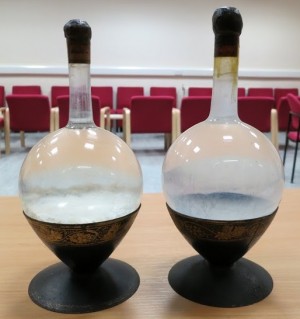“Strontia” and “Baryta”, Thomas Hope, 1791.
Discovery of the element strontium.
Exhibition samples of strontium and barium hydroxide prepared by Thomas Hope (Chair of Chemistry 1795–1844). Strontium is named after the village Strontian in Argyll, and Hope is often credited with identifying it as a new element, distinct from barium. The credit probably lies with William Cruikshank and Adair Crawford (1790), although Hope wrote that he had noted the distinction in his lectures as early as 1787. Crawford also studied in Edinburgh under Joseph Black (1777).
Early direct-vision spectroscope, Adam Hilger, 1879.
A spectroscope designed by an illustrious alumnus.
James Dewar was first a student and then an assistant in the School of Chemistry under Playfair and subsequently Crum Brown (1863–75). Dewar later became Professor of Chemistry at the Royal Institution (1877–1923), where he was the first to liquefy oxygen and other gases, and he invented the vacuum flask. The spectroscope on display was designed by Liveing (University of Cambridge) and Dewar; it was built by Adam Hilger in 1879 and cost £35. A larger version was supplied to the Duke of Marlborough at Blenheim in 1888 (present whereabouts unknown). The instrument was reconditioned by Hilger and Watts Ltd (1968) and is still in perfect working condition.
The School of Chemistry
Letter to James Smithson about construction of balance, Joseph Black, 1790.
The earliest analytical balance.
Joseph Black was first to use a balance to follow, and thereby rationalise, chemical reactions. The letter is written to James Smithson (1765–1829), whose bequest established the Smithsonian Institution. The letter describes a light beam of fir-wood, resting across a fine needle balanced over a small brass holder. The assembly would lie only about 4 mm above the table. Black writes, “I can learn the weight of any little mass, from 1 grain or a little more to the 1-1200th of a grain”, which in modern units corresponds to 65 mg down to 0.05 mg.
Special Collections Gen. 873/III/158

